Rongfei Jia
Mesh Silksong: Auto-Regressive Mesh Generation as Weaving Silk
Jul 03, 2025Abstract:We introduce Mesh Silksong, a compact and efficient mesh representation tailored to generate the polygon mesh in an auto-regressive manner akin to silk weaving. Existing mesh tokenization methods always produce token sequences with repeated vertex tokens, wasting the network capability. Therefore, our approach tokenizes mesh vertices by accessing each mesh vertice only once, reduces the token sequence's redundancy by 50\%, and achieves a state-of-the-art compression rate of approximately 22\%. Furthermore, Mesh Silksong produces polygon meshes with superior geometric properties, including manifold topology, watertight detection, and consistent face normals, which are critical for practical applications. Experimental results demonstrate the effectiveness of our approach, showcasing not only intricate mesh generation but also significantly improved geometric integrity.
Hyper3D: Efficient 3D Representation via Hybrid Triplane and Octree Feature for Enhanced 3D Shape Variational Auto-Encoders
Mar 13, 2025Abstract:Recent 3D content generation pipelines often leverage Variational Autoencoders (VAEs) to encode shapes into compact latent representations, facilitating diffusion-based generation. Efficiently compressing 3D shapes while preserving intricate geometric details remains a key challenge. Existing 3D shape VAEs often employ uniform point sampling and 1D/2D latent representations, such as vector sets or triplanes, leading to significant geometric detail loss due to inadequate surface coverage and the absence of explicit 3D representations in the latent space. Although recent work explores 3D latent representations, their large scale hinders high-resolution encoding and efficient training. Given these challenges, we introduce Hyper3D, which enhances VAE reconstruction through efficient 3D representation that integrates hybrid triplane and octree features. First, we adopt an octree-based feature representation to embed mesh information into the network, mitigating the limitations of uniform point sampling in capturing geometric distributions along the mesh surface. Furthermore, we propose a hybrid latent space representation that integrates a high-resolution triplane with a low-resolution 3D grid. This design not only compensates for the lack of explicit 3D representations but also leverages a triplane to preserve high-resolution details. Experimental results demonstrate that Hyper3D outperforms traditional representations by reconstructing 3D shapes with higher fidelity and finer details, making it well-suited for 3D generation pipelines.
NeuDA: Neural Deformable Anchor for High-Fidelity Implicit Surface Reconstruction
Mar 04, 2023Abstract:This paper studies implicit surface reconstruction leveraging differentiable ray casting. Previous works such as IDR and NeuS overlook the spatial context in 3D space when predicting and rendering the surface, thereby may fail to capture sharp local topologies such as small holes and structures. To mitigate the limitation, we propose a flexible neural implicit representation leveraging hierarchical voxel grids, namely Neural Deformable Anchor (NeuDA), for high-fidelity surface reconstruction. NeuDA maintains the hierarchical anchor grids where each vertex stores a 3D position (or anchor) instead of the direct embedding (or feature). We optimize the anchor grids such that different local geometry structures can be adaptively encoded. Besides, we dig into the frequency encoding strategies and introduce a simple hierarchical positional encoding method for the hierarchical anchor structure to flexibly exploit the properties of high-frequency and low-frequency geometry and appearance. Experiments on both the DTU and BlendedMVS datasets demonstrate that NeuDA can produce promising mesh surfaces.
3D Scene Creation and Rendering via Rough Meshes: A Lighting Transfer Avenue
Dec 04, 2022Abstract:This paper studies how to flexibly integrate reconstructed 3D models into practical 3D modeling pipelines such as 3D scene creation and rendering. Due to the technical difficulty, one can only obtain rough 3D models (R3DMs) for most real objects using existing 3D reconstruction techniques. As a result, physically-based rendering (PBR) would render low-quality images or videos for scenes that are constructed by R3DMs. One promising solution would be representing real-world objects as Neural Fields such as NeRFs, which are able to generate photo-realistic renderings of an object under desired viewpoints. However, a drawback is that the synthesized views through Neural Fields Rendering (NFR) cannot reflect the simulated lighting details on R3DMs in PBR pipelines, especially when object interactions in the 3D scene creation cause local shadows. To solve this dilemma, we propose a lighting transfer network (LighTNet) to bridge NFR and PBR, such that they can benefit from each other. LighTNet reasons about a simplified image composition model, remedies the uneven surface issue caused by R3DMs, and is empowered by several perceptual-motivated constraints and a new Lab angle loss which enhances the contrast between lighting strength and colors. Comparisons demonstrate that LighTNet is superior in synthesizing impressive lighting, and is promising in pushing NFR further in practical 3D modeling workflows. Project page: https://3d-front-future.github.io/LighTNet .
DCCF: Deep Comprehensible Color Filter Learning Framework for High-Resolution Image Harmonization
Jul 13, 2022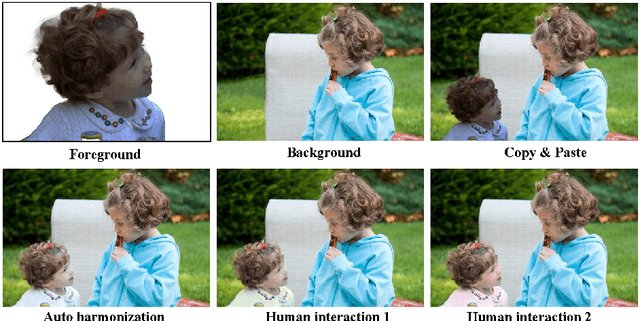



Abstract:Image color harmonization algorithm aims to automatically match the color distribution of foreground and background images captured in different conditions. Previous deep learning based models neglect two issues that are critical for practical applications, namely high resolution (HR) image processing and model comprehensibility. In this paper, we propose a novel Deep Comprehensible Color Filter (DCCF) learning framework for high-resolution image harmonization. Specifically, DCCF first downsamples the original input image to its low-resolution (LR) counter-part, then learns four human comprehensible neural filters (i.e. hue, saturation, value and attentive rendering filters) in an end-to-end manner, finally applies these filters to the original input image to get the harmonized result. Benefiting from the comprehensible neural filters, we could provide a simple yet efficient handler for users to cooperate with deep model to get the desired results with very little effort when necessary. Extensive experiments demonstrate the effectiveness of DCCF learning framework and it outperforms state-of-the-art post-processing method on iHarmony4 dataset on images' full-resolutions by achieving 7.63% and 1.69% relative improvements on MSE and PSNR respectively.
Ray Priors through Reprojection: Improving Neural Radiance Fields for Novel View Extrapolation
May 12, 2022
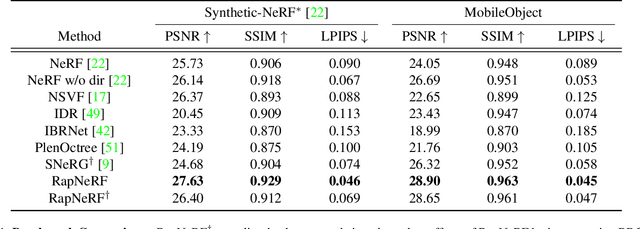

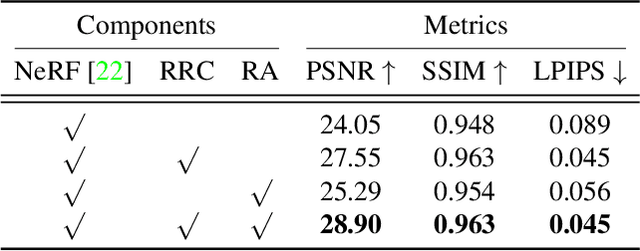
Abstract:Neural Radiance Fields (NeRF) have emerged as a potent paradigm for representing scenes and synthesizing photo-realistic images. A main limitation of conventional NeRFs is that they often fail to produce high-quality renderings under novel viewpoints that are significantly different from the training viewpoints. In this paper, instead of exploiting few-shot image synthesis, we study the novel view extrapolation setting that (1) the training images can well describe an object, and (2) there is a notable discrepancy between the training and test viewpoints' distributions. We present RapNeRF (RAy Priors) as a solution. Our insight is that the inherent appearances of a 3D surface's arbitrary visible projections should be consistent. We thus propose a random ray casting policy that allows training unseen views using seen views. Furthermore, we show that a ray atlas pre-computed from the observed rays' viewing directions could further enhance the rendering quality for extrapolated views. A main limitation is that RapNeRF would remove the strong view-dependent effects because it leverages the multi-view consistency property.
NeRF-Editing: Geometry Editing of Neural Radiance Fields
May 10, 2022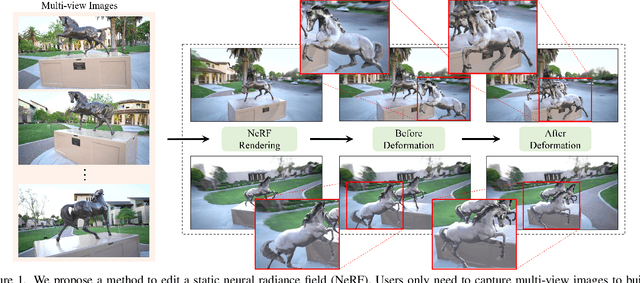



Abstract:Implicit neural rendering, especially Neural Radiance Field (NeRF), has shown great potential in novel view synthesis of a scene. However, current NeRF-based methods cannot enable users to perform user-controlled shape deformation in the scene. While existing works have proposed some approaches to modify the radiance field according to the user's constraints, the modification is limited to color editing or object translation and rotation. In this paper, we propose a method that allows users to perform controllable shape deformation on the implicit representation of the scene, and synthesizes the novel view images of the edited scene without re-training the network. Specifically, we establish a correspondence between the extracted explicit mesh representation and the implicit neural representation of the target scene. Users can first utilize well-developed mesh-based deformation methods to deform the mesh representation of the scene. Our method then utilizes user edits from the mesh representation to bend the camera rays by introducing a tetrahedra mesh as a proxy, obtaining the rendering results of the edited scene. Extensive experiments demonstrate that our framework can achieve ideal editing results not only on synthetic data, but also on real scenes captured by users.
Modeling Indirect Illumination for Inverse Rendering
Apr 14, 2022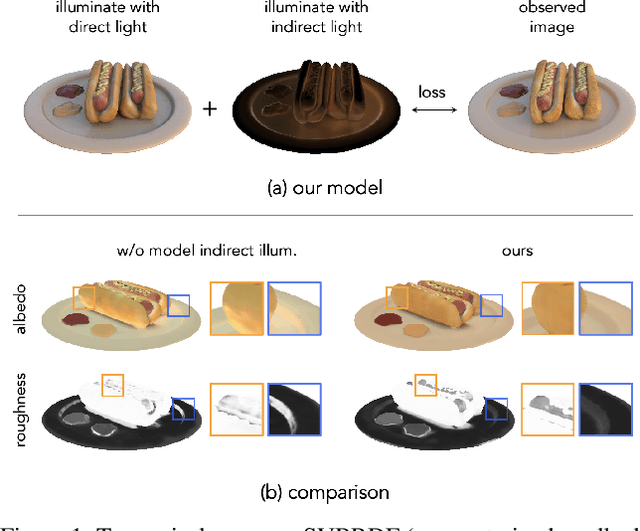


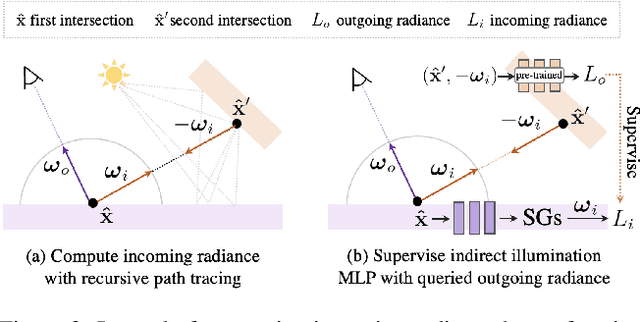
Abstract:Recent advances in implicit neural representations and differentiable rendering make it possible to simultaneously recover the geometry and materials of an object from multi-view RGB images captured under unknown static illumination. Despite the promising results achieved, indirect illumination is rarely modeled in previous methods, as it requires expensive recursive path tracing which makes the inverse rendering computationally intractable. In this paper, we propose a novel approach to efficiently recovering spatially-varying indirect illumination. The key insight is that indirect illumination can be conveniently derived from the neural radiance field learned from input images instead of being estimated jointly with direct illumination and materials. By properly modeling the indirect illumination and visibility of direct illumination, interreflection- and shadow-free albedo can be recovered. The experiments on both synthetic and real data demonstrate the superior performance of our approach compared to previous work and its capability to synthesize realistic renderings under novel viewpoints and illumination. Our code and data are available at https://zju3dv.github.io/invrender/.
Data-Free Evaluation of User Contributions in Federated Learning
Aug 24, 2021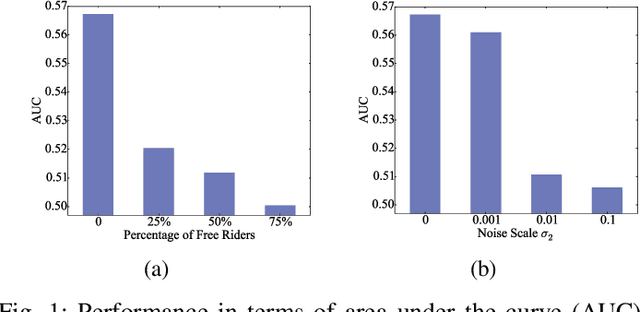
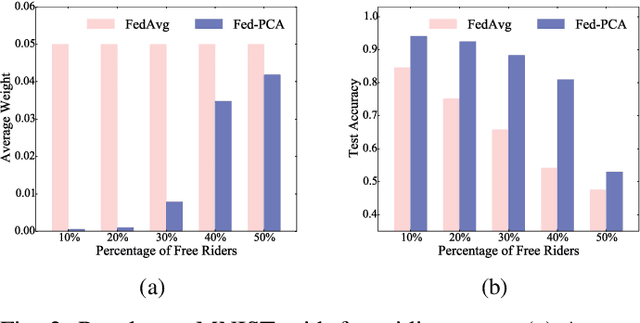
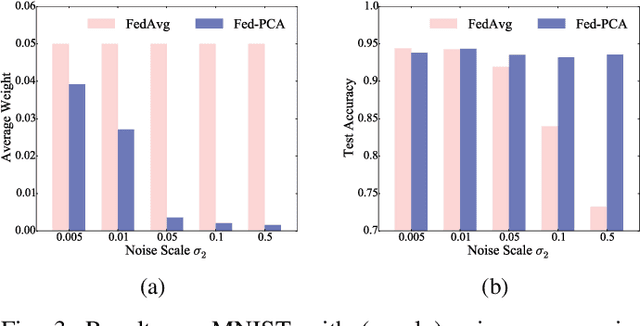
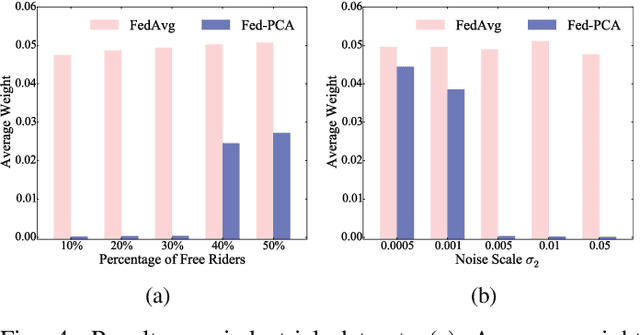
Abstract:Federated learning (FL) trains a machine learning model on mobile devices in a distributed manner using each device's private data and computing resources. A critical issues is to evaluate individual users' contributions so that (1) users' effort in model training can be compensated with proper incentives and (2) malicious and low-quality users can be detected and removed. The state-of-the-art solutions require a representative test dataset for the evaluation purpose, but such a dataset is often unavailable and hard to synthesize. In this paper, we propose a method called Pairwise Correlated Agreement (PCA) based on the idea of peer prediction to evaluate user contribution in FL without a test dataset. PCA achieves this using the statistical correlation of the model parameters uploaded by users. We then apply PCA to designing (1) a new federated learning algorithm called Fed-PCA, and (2) a new incentive mechanism that guarantees truthfulness. We evaluate the performance of PCA and Fed-PCA using the MNIST dataset and a large industrial product recommendation dataset. The results demonstrate that our Fed-PCA outperforms the canonical FedAvg algorithm and other baseline methods in accuracy, and at the same time, PCA effectively incentivizes users to behave truthfully.
Exploiting Diverse Characteristics and Adversarial Ambivalence for Domain Adaptive Segmentation
Jan 07, 2021
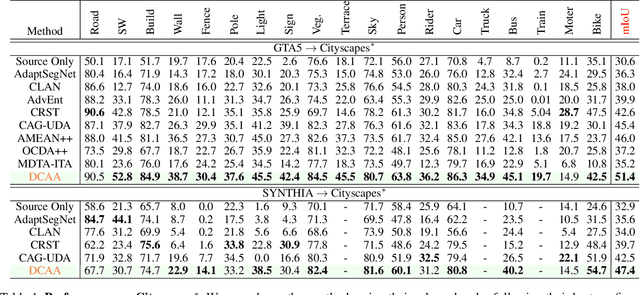
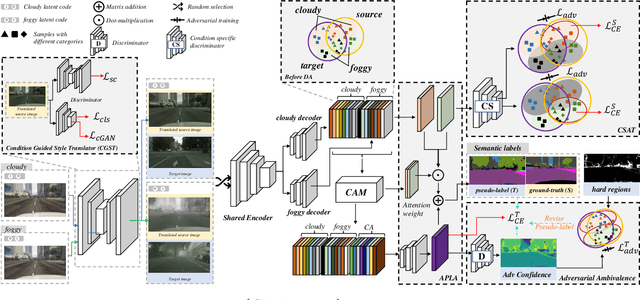
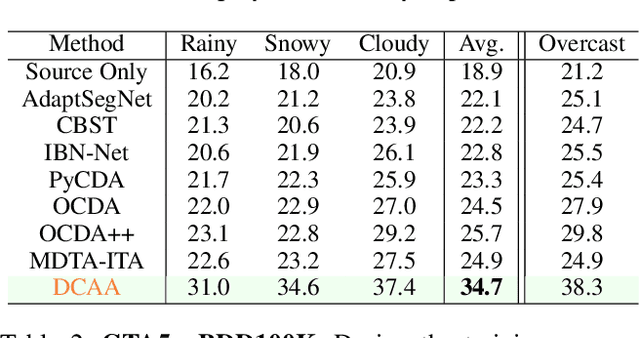
Abstract:Adapting semantic segmentation models to new domains is an important but challenging problem. Recently enlightening progress has been made, but the performance of existing methods are unsatisfactory on real datasets where the new target domain comprises of heterogeneous sub-domains (e.g., diverse weather characteristics). We point out that carefully reasoning about the multiple modalities in the target domain can improve the robustness of adaptation models. To this end, we propose a condition-guided adaptation framework that is empowered by a special attentive progressive adversarial training (APAT) mechanism and a novel self-training policy. The APAT strategy progressively performs condition-specific alignment and attentive global feature matching. The new self-training scheme exploits the adversarial ambivalences of easy and hard adaptation regions and the correlations among target sub-domains effectively. We evaluate our method (DCAA) on various adaptation scenarios where the target images vary in weather conditions. The comparisons against baselines and the state-of-the-art approaches demonstrate the superiority of DCAA over the competitors.
 Add to Chrome
Add to Chrome Add to Firefox
Add to Firefox Add to Edge
Add to Edge